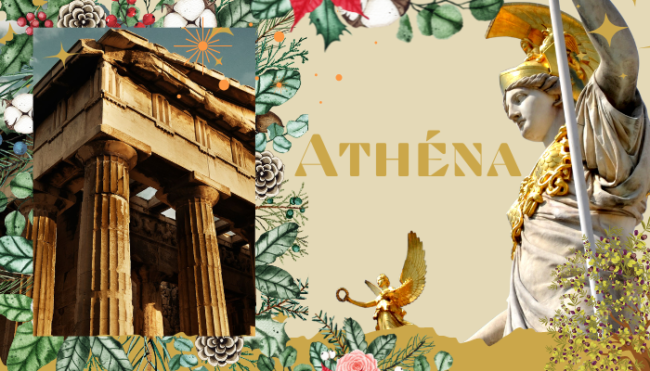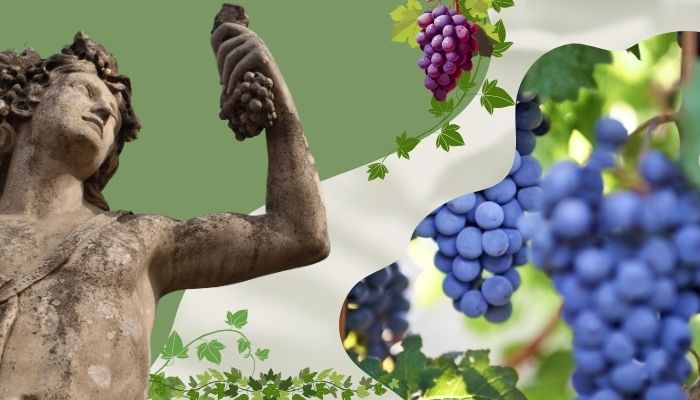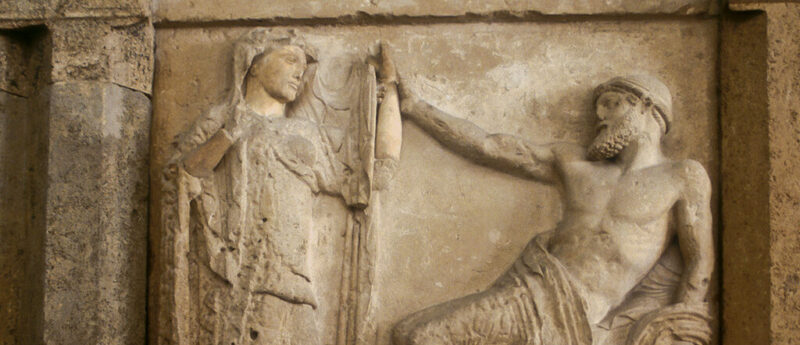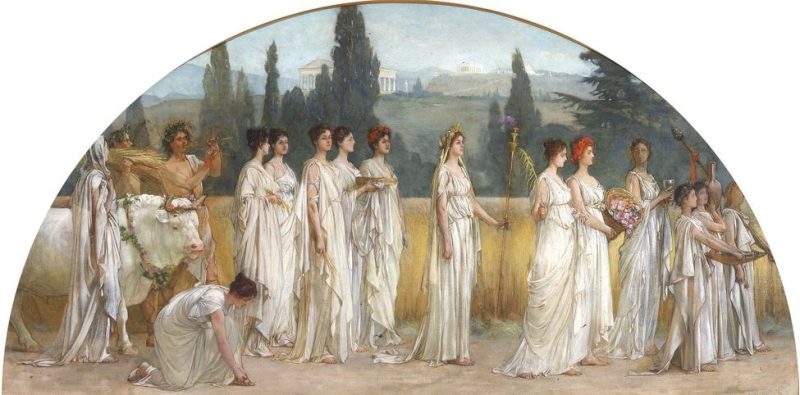Athena was the goddess of wisdom, reason, prudence, the arts and combat. She’s also the patron goddess of Athens. But who is she really? She’s a woman, and in the Olympian world, she stands apart, so powerful, so cerebral…always one step ahead…hard not to admire her! She’s THE goddess incarnate, unapproachable, dark and protective, so we tell you more!
Birth of Athena
Athena was the daughter of Zeus and Métis (one of the Oceanides). Zeus swallowed Metis, fearing the birth of a child who might have been more knowledgeable and powerful than him. Nine months later, Zeus, overwhelmed by a violent headache, ordered Hephaestus to split his brain with an axe, and Athena emerged fully armed from her father’s head. Phidias immortalized this scene on the pediment of the Parthenon temple. In fact, if you look closely at the temples, sanctuaries and myths, you’ll soon notice the connivance between father and daughter, between Zeus and Athena. Wherever Athena may be, Zeus is never far away: she’s his “pet”, his pride, a part of him.
The two sides of Athena
They can be divided into two categories:
- the warrior character of the goddess,
- its role as protector of the arts and peace, and patron saint of artisans and crafts.
All surviving statues of Athena belong to these two types. On the one hand, the goddess appears as a fully-armed fighter. His aegis (cape) adorned with snakes covers his chest or extends over his left arm. The aegis is made from the skin of the Amalthea goat and protects Athena like a shield. With her right arm, she holds her spear. On the other hand, when the goddess is in a state of serenity, she wears a long tunic and her facial features express grandeur and nobility.
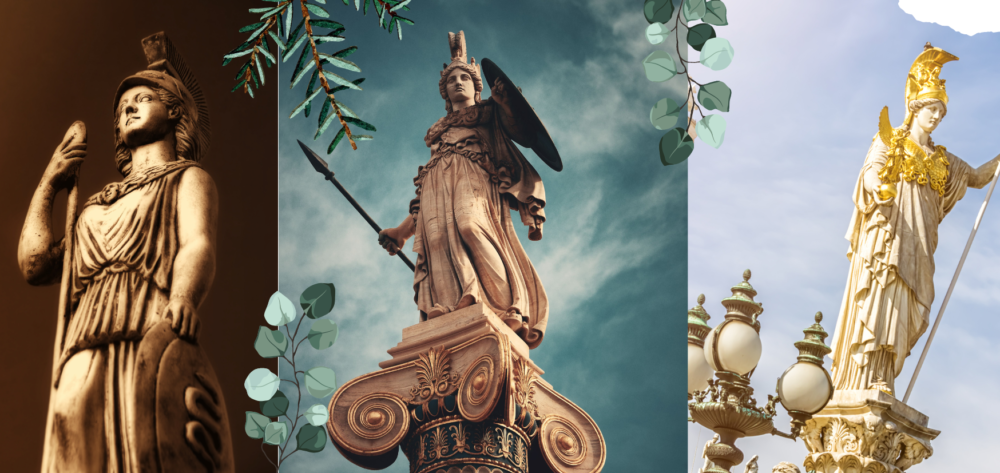
Nicknames for the goddess Athena
His innumerable nicknames recall the circumstances of his birth, his physiognomy or his attributes:
– Agoraia (goddess of the Agora, public square)
– Ergane (the worker, protector of artisans).
– Hippia (protector of horses).
– Nike (the victor).
– Parthenos or Pallas (the young girl, the virgin).
– Polias (city guardian).
– Promachos (warrior, the one who fights first).
– Hygieia (protector of health).
These epithets reveal the different aspects of Athena. Look closely at these etymological titles: like Hygieia, we have the word “hygiene”. It’s up to you to find the others!
Its main symbols :
The owl, the olive tree, the snake and the Gorgoneion (Medusa’s head).
Athenian coins, the tetradrachms, featured Athena’s head on one side and an owl on the other. This piece, which spread throughout the Mediterranean, was the first “international” play. Today, this coin can be found on the Greek euro, as they are identical. Nice story, but are Athena and the euro still protecting Greece?

Athena’s warlike nature
It predominates in the sagas and Homeric hymns. She took part in the Titanomachy and also helped the Athenians against the Persians. In the Iliad, she assists the Greeks (Achaeans) and in the Odyssey, she is Odysseus’ divine advisor. Through the myth of Arachne, for example, we can discover her strong character!
Peaceful living under Athena’s patronage
Athena created the Areopagus (Athens’ court of law) and founded the principles of Athens’ law.
- Near the Propylaea, the monumental entrance to the Acropolis, there was an altar dedicated to Athena Hygieia.
In the ancient Agora, in front of the temple of Hephaestus, stood the statue of Athena Ergane, protector of artisans. - Still on the Acropolis, just beyond the Propylaea, Phidias erected a large statue of Athena Promachos (Warrior), 9 meters high.
- The cella, the central part of the Parthenon, was dominated by the splendid statue of Athena Parthenos (Virgin). Created by Phidias, 12 meters high, it was chryselephantine (made of gold and ivory).
- The west pediment of the Parthenon depicts the dispute between Athena and Poseidon over the protection of the city of Athens. Athena won the contest, having offered the Athenians the sacred olive tree. Since then, the city has been called Athens, after its beloved goddess, Athena.
- The Erectheion temple housed a wooden statue (known as a xoanon) of Athena Polias (protector of the city).
On and around the Acropolis, Athena is present. Like a pledge of security, she gives positive strength to every Athenian. Everyone can identify with or relate to this goddess who is so powerful, so strategic and somehow also maternal. She plays the role of what the Athenians worshipped most in the world: “the coach” who helps you to excel.
The Panathenaeums
The biggest festival dedicated to Athena was the Panathenaeum. This whole town took part. Athenians then wore the peplos (veil) to Athena Polias on the Acropolis.
Phidias’ disciples depicted this procession to the Acropolis in relief on the famous frieze of the Parthenon. Gods and men are both familiar and superhuman. Young and old, young girls and young men, gods, citizens, slaves and animals, everyone takes part in this immense festive ceremony that transports the spectator.
This is the famous Parthenon frieze that you can admire at the Acropolis Museum.
A city, Athens, and a goddess, Athena, span the centuries, yet remain intrinsically linked. Even today, if you look hard enough, if you observe carefully, it’s there, like a mirror effect between the city and its goddess.
Visiting Athens with your family:
Here are the places in Athens that are directly related to Athena:
If you’d like to discover other gods and myths, click on our mythology section!
Mania and Céline P.
